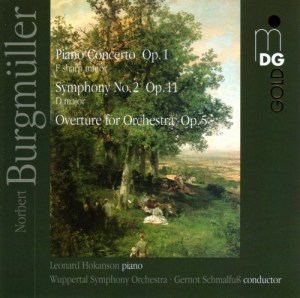 |
 |
|

Support us financially by purchasing this disc from: |
|
|
|
|
|
Norbert BURGMÜLLER (1810-1836)
Overture in F, Op. 5 [12:23]
Symphony No. 2 in D, Op. 11 [31:51]
Piano Concerto in F sharp minor, Op. 1 [33:25]
 Leonard Hokanson (piano)
Leonard Hokanson (piano)
Wuppertal Symphony Orchestra/Gernot Schmalfuß
ec. 21-22 and 25 August (overture, symphony) and 1-2 December
(concerto) 1997, Stadthalle Wuppertal, Germany
 MUSIKPRODUKTION DABRINGHAUS UND GRIMM MDG 335 0817-2 [77:38]
MUSIKPRODUKTION DABRINGHAUS UND GRIMM MDG 335 0817-2 [77:38]
|
|
|
I wish I could be more positive about Norbert Burgmüller except
to say that he had considerable promise as a composer before dying at age
26. The three works here are illustrative of his potential, his shortcomings
and his sudden death. The piano concerto and overture have moments of
inspiration, but the symphony is merely diverting before it suddenly and
jarringly ends.
I’ll take the concerto first. It benefits from three
innovative twists: the fascinating key of F sharp minor, a slow movement
which has an extensive cello solo, and a refusal to switch to the major in
the stormy final coda. The opening, with the piano calming down a grandiose
Sturm-und-Drang orchestra, foreshadows Brahms’ first concerto.
The larghetto with its graceful cello calls to mind Tchaikovsky. Maybe the
most remarkable thing about the piece is how little trace one feels of the
shadow of Beethoven. On the other hand, there is a lot of Schubert.
There is even more Schubert in the symphony, which feels like three
unrelated parts joined together. The first movement is a lovely pastoral
which comes close to quoting Schubert in its development but lacks the
catchy tunes of the other, better composer. The andante bears an obvious
resemblance to the andante from Schubert’s last symphony: a solo theme
for the oboe, delivered over walking-pace string accompaniment. Then comes
the scherzo, which is charming but ends unexpectedly in a minor key. Since
Burgmüller died before composing the finale, we’ll never know
exactly what he meant by this symphony, which as is begins in a bucolic D
major but ends in a surprising state of agitation. It should be noted that,
according to the booklet’s translation, “He did not work out all
of the third movement either. Robert Schumann instrumented [sic] the
sketches.”
Schumann no doubt also knew about the overture, which might be my
favorite piece here. Still, Burgmüller was not really capable of
writing memorable tunes, which is why his music often sounds like Schubert
without the depth or memorable substance. Then again, Schubert lived to 31.
Burgmüller didn’t even have that good fortune.
This is a reissue of a 1996 recording which sounds perfectly good;
the very good pianist, Leonard Hokanson, is very naturally balanced against
the orchestra. A more incisive performance of the symphony on period
instruments can be heard on Carus (Hofkapelle Stuttgart, Frieder Bernius),
coupled with the composer’s other (completed) symphony. If
you’re interested in the piano concerto, or you collect such
early-romantic byways, this is one of the more interesting ones, though it
is probably not essential.
Brian Reinhart
Support us financially by purchasing this disc from:
|
|
|
|
|
|
|
|
|